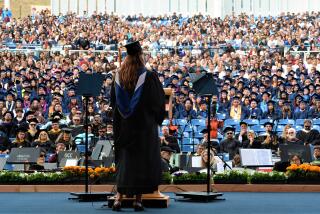Lessons Well-Learned
- Share via
When it comes to college scholarships, it’s hard to beat the five offered by Orange Coast College.
The scholarships in this case were for the school’s sailing program, and the winners wound up being rescued in the Pacific midway between Honolulu and Orange County. It is fortunate they were not injured, and it is a tribute to the college and its emphasis on safety at sea that the students emerged from their experience with sea stories rather than bruises, broken bones or worse.
Orange Coast flew the students to Hawaii last month to become the crew of the 66-foot sailboat Bonaire. The boat, which was donated to the school, had been chartered for the Los Angeles-Honolulu Transpacific Yacht Race, held every two years. But the crew that sailed the boat to Hawaii had no interest in bringing it back, so the students were recruited.
The return voyage was expected to take a bit more than two weeks, but after 15 days at sea, the 80-foot mast became dislodged for unknown reasons.
Masts have been known to snap on racing boats, including in the Transpac race. But usually it happens en route to Hawaii, where gung-ho captains try to squeeze every extra knot out of their boats. And those boats usually are crewed by half a dozen or more fully experienced sailors, trained to handle most emergencies.
Bonaire, by contrast, had five students with relatively limited sailing experience. The captain of the vessel, Marcus Mackenzie, and the two first mates deserve credit for ensuring that when the mast fell there was no panic.
Robert Pelletier, one of the student sailors, said the first half-hour was a scramble, and he thought the boat was going to sink right then. But in a classic instance of doing the right thing, the crew assembled on deck, put on life preservers and sent out a mayday call.
Pelletier said there was little immediate danger because the sea was calm, the lifeboats were ready to board and the Coast Guard knew the location of the Bonaire. That’s a demonstration of the worth of Global Positioning System satellites, which let a boat determine its exact latitude and longitude. It also shows the importance of good radio equipment that let the Bonaire keep the Coast Guard up to date on its whereabouts. But despite the relative absence of danger, there was always the chance the mast would punch a hole in the boat’s hull, allowing water to flood in.
It took two days for the Coast Guard to find ships close enough to the Bonaire with the equipment needed to handle an at-sea transfer of crew, but a German freighter and a Japanese automobile carrier eventually picked up all eight sailors. The Bonaire was left to sink.
Orange Coast has long had a good sailing program, teaching thousands how to handle vessels ranging in size from 14-foot boats to yachts like Bonaire. It also provides valuable instruction in celestial navigation, emergency medicine at sea and other topics. As it should, it also stresses safety, a lesson that paid off northeast of Hawaii.


